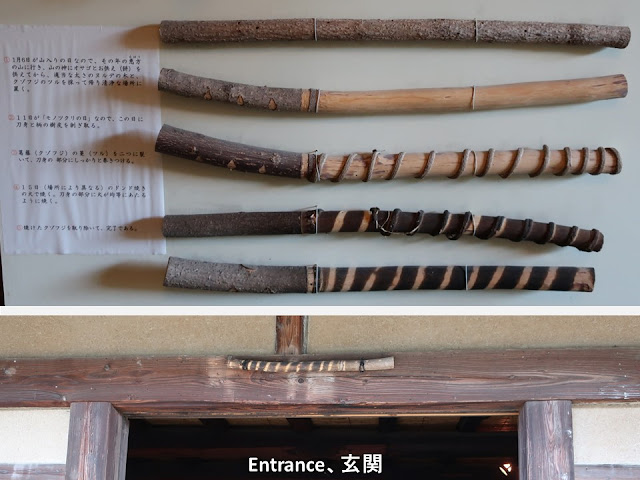“Chaya(teahouse)-honjin” was a resting place for daimyo
lords and nobles. However, there were no rooms to stay
overnight. Goryo Chaya-honjin is located at Nakasendou (highway) in mountainous
area of Gunma Prefecture. The map is shown at the bottom of this article.
“Chaya-honjin” were residences of two Nakajima families.
The families served as a village head during in the Edo period (1603~1868). Old
utensils, historical documents and excavated artifacts are exhibited inside the
buildings, so they look like history and folklore museums.
I introduce Usui check point, Oginoya (famous bento
restaurant) and Sakamoto post town together.
中山道を通行した大名や公家が休息した施設です。名主屋敷であり、茶屋本陣には宿泊できる広さではありませんが、江戸時代から残る建物は風格が十分。「お東」「お西」と呼ばれる二軒の中島家が交代で名主を務めていました。屋敷内には近世の民具や古文書、古代の発掘品が多数展示されていて、郷土博物館のようです。
近くにある碓氷関所、峠の釜めしの荻野屋さん、その先の坂本宿も紹介します。
The residence, which was built in 1806 and used as "Chaya honjin", is called “O-nishi (west)”; it has a white sand garden in front.
「お西」は1806年に建てられました。白砂の庭園があります。
Inside the entrance, there are an earthen-floor kitchen and a living room with a fireplace “Iori”. It’s typical layout of farmer’s house.
玄関を入ると、土間、囲炉裏があります。農家の造りですね。
Surprisingly enough, there is a bathing space beside the entrance! They washed bodies on the bamboo stage in summer; they installed a bath tub in cold winter there. The used water was collected under the stage. They poured it to feces and urine, then those were used as fertilizer. They didn’t waste even their old skin.
玄関の左側が、なんと、風呂スペース。夏は竹のスノコの上で体を洗い、冬は風呂桶を置きました。何とオープンなスペース。スノコから落ちた水は、し尿と混ぜて肥料にしました。垢すらも無駄にしませんでした。
There is a classy resting space on behind.
奥には貴人の休息所があります。
The wooden box was used to carry daimyo lords’ documents. It was equipped at Sakamoto post town; the documents were carried to the next post town. The vacant box returned to Sakamoto.
大名の書類などを運ぶための御用書類箱が展示されています。坂本宿の問屋場に置かれ、隣の宿(軽井沢宿・松井田宿)と往復しました。絵は、歌川広重の「藤枝 人馬継立」(国立国会図書館デジタルコレクション)です。
We can see craggy mountains (Mt. Myogi) beyond the garden. The electric wires are for train (Shinetsu Line).
庭先には、奇峰の妙義山が見えます。電線は、信越線のものです。
There are many exhibits on the 2nd floor. I highlight tableware.
二階には、民俗資料館を凌ぐ品が展示されています。その中から、食事関係の民具を紹介します。
We Japanese didn’t use a dining table until European lifestyle penetrated around hundred years ago.
Everyone had its own “Hako(box)-zen(tray)”, and kept its tableware in it. Dishes were put on it during dinner. “Hon(official)-zen(tray)” was used at official dinners such as wedding ceremony. “Kiri(cut) dame(storage)” is a set of wooden boxes to keep prepared ingredients.
左から、日常使用する箱膳、冠婚葬祭に使う本膳、切溜。切溜は入れ子式で、切った材料を溜めておく箱でした。
Lunch boxes are also exhibited. Those are unfamiliar shape and deep.
変わった形の弁当箱で、しかも深いです。
“O-higashi” was also built in 1806, because both buildings burned down at the same time.
お東も1806年に建てられました。1806年に火災があって、その年の内に二棟とも再建されました。
Inside the entrance, there is a space for horses on the right. There is a bathing space on the left; it’s same as “O-nishi”.
玄関を入ると右側が馬屋。左は、お西と同じく風呂スペースでした。
Many New Year’s decorations are displayed.
小正月の飾りが多数展示されています。
Wooden swords are made in the New Year in order to drive devils away. Those are displayed on the entrance door and on the family shrine shelf.
On the 6th of January, people go to the mountain located in the lucky direction of the year (ehou), and offer something to the mountain god. Afterwards, they bring branches to their home. They make wood swords on the specified day, and grill swords by the fire of Dondo rite on the mid-January.
正月には、魔除けの道祖神の太刀を作ります。1月6日の山入りの日に、恵方の山へ行き、山の神にお供えをしてから、木を持ち帰ります。決められた日に加工し、小正月のどんど焼きの火で焼いて完成です。玄関と神棚に飾っていました。
Chaya honjin and a car park are beyond the railroad crossing.
狭い道の先の踏切を渡ると五料茶屋本陣と駐車場です。
Usui checkpoint (sekisho)、碓氷関所
Usui checkpoint was an important facility of Nakasendou highway which linked Edo (old name of Tokyo) and Kyoto through inland. Parts of the pillars, the door and the roof were made in the Edo period (1603~1868). The foundation stones supported the gate even in the period.
中山道の要所、碓氷関所の門は、1959年に再建されました。門柱、門扉、屋根材の一部はや台石は江戸時代のものです。すごいですねえ。門の前に小さな「碓氷関史料館」がありますが、開館は休日のみでした。
Near the checkpoint, there is Yokokawa railway station and Oginoya restaurant. They sell bento to passengers; it is named “Touge-no (at the pass) Kamameshi (rice, meat and vegetable dish cooked and served in a small pot)”. It’s one of the most famous bento which is sold at the station; “Eki(station)-ben(bento)”.
関所のすぐ横に、横川駅があり、「峠の釜めし」の荻野屋さんがあります。
I ordered “Touge-no-Kamameshi” and miso soup.
釜飯を定食でいただきました。味噌汁と甘味が付きます。
The restaurant owns a tiny museum on the opposite side of the road. Its name is “Oginoya museum (Touge-no-Kamameshi museum)”.
The photo attracts me. Staff deeply bow to
customers in the train. It’s very Japanese.
お店の向かいには、「おぎのや資料館(峠の釜めし資料館)」という小さな展示施設があります。
駅で、釜めしを売っている写真、じゃなくて、そのあと、車内のお客様にお辞儀をする写真にひかれました。感謝の気持ちが伝わります。今や、飛行機の整備士さんが滑走路に向かう飛行機に手を振る”Good-bye Wave”が世界各地で見られますが、これは沖縄空港のANAで始まったそうです。日本人らしい振る舞いですね。
Touge-no-Kamameshi for royal family is served with rich ingredients and fruits.
皇室用の「峠の釜めし」はフルーツ付きで、炊き込みご飯の上の具材が多いです。
Sakamoto post town is located between the checkpoint and Usui pass. The aged building “Kagiya” on the left was an inn.
関所を過ぎて峠に向かうと坂本宿。左側は元旅籠の「かぎや」さんです。
If you go up futher, you can see an arched brick bridge. It was built for train in 1892. The construction period was only three months (reinforced later). What a great project! It is out-of-use now, but it gathers many tourists.
Beyond the pass, you can reach Karuizawa in Nagano prefecture.
Reference: The Karuizawa Museum of History and Culture、軽井沢歴史民俗資料館
更に登っていくと、鉄道の開通とともにできた眼鏡橋があります。鉄道は廃線になりましたが、今も人気の観光地です。煉瓦造りのアーチ橋で、1892年に工期三ヶ月で完成させました(その後、補強)。大したものです。
峠を越えると、長野県軽井沢です。
Visited in October, 2021
Official website: https://www.city.annaka.lg.jp/gakushuunomori/bunkazai/goryouchaya.html
(in Japanese), accessed in February, 2022
Previous post (Old samurai’s houses in Annaka): Samurai residences in Annaka、旧安中藩武家屋敷
Next post (Museum in the neighboring prefecture): Nagano Prefectural Museum of History、長野県立歴史館
























Comments
Post a Comment